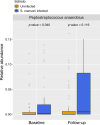Cervicovaginal bacterial communities in reproductive-aged Tanzanian women with Schistosoma mansoni, Schistosoma haematobium, or without schistosome infection
- PMID: 33408370
- PMCID: PMC8115289
- DOI: 10.1038/s41396-020-00868-9
Cervicovaginal bacterial communities in reproductive-aged Tanzanian women with Schistosoma mansoni, Schistosoma haematobium, or without schistosome infection
Abstract
Schistosome infection is recognized as a potentially modifiable risk factor for HIV in women by the World Health Organization. Alterations in cervicovaginal bacteria have been associated with HIV acquisition and have not been studied in schistosome infection. We collected cervical swabs from Tanzanian women with and without S. mansoni and S. haematobium to determine effects on cervicovaginal microbiota. Infected women were treated, and follow-up swabs were collected after 3 months. 16S rRNA sequencing was performed on DNA extracted from swabs. We compared 39 women with S. mansoni with 52 uninfected controls, and 16 with S. haematobium with 27 controls. S. mansoni-infected women had increased abundance of Peptostreptococcus (p = 0.026) and presence of Prevotella timonesis (p = 0.048) compared to controls. High-intensity S. haematobium infection was associated with more diverse cervicovaginal bacterial communities than uninfected controls (p = 0.0159). High-intensity S. mansoni infection showed a similar trend (p = 0.154). At follow-up, we observed increased alpha diversity in S. mansoni (2.53 vs. 1.72, p = 0.022) and S. haematobium (2.05 vs. 1.12, p = 0.066) infection groups compared to controls. Modifications in cervicovaginal microbiota, particularly increased diversity and abundance of taxa associated with bacterial vaginosis and HIV (Peptostreptococcus, Prevotella), were associated with schistosome infection.
Keywords: Cervicovaginal microbiota; HIV; Microbiome; Schistosomiasis; Tanzania.
Conflict of interest statement
The authors declare that they have no conflict of interest.
Figures





Similar articles
-
Altered Cervical Mucosal Gene Expression and Lower Interleukin 15 Levels in Women With Schistosoma haematobium Infection but Not in Women With Schistosoma mansoni Infection.J Infect Dis. 2019 May 5;219(11):1777-1785. doi: 10.1093/infdis/jiy742. J Infect Dis. 2019. PMID: 30590736 Free PMC article.
-
Schistosomiasis and hydration status: Schistosoma haematobium, but not Schistosoma mansoni increases urine specific gravity among rural Tanzanian women.Am J Phys Anthropol. 2018 Aug;166(4):952-959. doi: 10.1002/ajpa.23479. Epub 2018 Apr 17. Am J Phys Anthropol. 2018. PMID: 29664990 Free PMC article.
-
Efficacy of praziquantel and reinfection patterns in single and mixed infection foci for intestinal and urogenital schistosomiasis in Cameroon.Acta Trop. 2013 Nov;128(2):275-83. doi: 10.1016/j.actatropica.2013.06.007. Epub 2013 Jun 20. Acta Trop. 2013. PMID: 23791803
-
Gender-related differences in prevalence, intensity and associated risk factors of Schistosoma infections in Africa: A systematic review and meta-analysis.PLoS Negl Trop Dis. 2021 Nov 17;15(11):e0009083. doi: 10.1371/journal.pntd.0009083. eCollection 2021 Nov. PLoS Negl Trop Dis. 2021. PMID: 34788280 Free PMC article.
-
Challenges in predicting the effects of climate change on Schistosoma mansoni and Schistosoma haematobium transmission potential.Trends Parasitol. 2013 Nov;29(11):548-55. doi: 10.1016/j.pt.2013.08.007. Epub 2013 Sep 21. Trends Parasitol. 2013. PMID: 24064438 Review.
Cited by
-
Female genital schistosomiasis is a neglected public health problem in Tanzania: Evidence from a scoping review.PLoS Negl Trop Dis. 2024 Mar 11;18(3):e0011954. doi: 10.1371/journal.pntd.0011954. eCollection 2024 Mar. PLoS Negl Trop Dis. 2024. PMID: 38466660 Free PMC article.
-
Effects of Schistosoma haematobium infection and treatment on the systemic and mucosal immune phenotype, gene expression and microbiome: A systematic review.PLoS Negl Trop Dis. 2024 Sep 9;18(9):e0012456. doi: 10.1371/journal.pntd.0012456. eCollection 2024 Sep. PLoS Negl Trop Dis. 2024. PMID: 39250522 Free PMC article.
-
Association of Female Genital Schistosomiasis With the Cervicovaginal Microbiota and Sexually Transmitted Infections in Zambian Women.Open Forum Infect Dis. 2021 Aug 22;8(9):ofab438. doi: 10.1093/ofid/ofab438. eCollection 2021 Sep. Open Forum Infect Dis. 2021. PMID: 34557562 Free PMC article.
-
Schistosomiasis-Microbiota Interactions: A Systematic Review and Meta-Analysis.Pathogens. 2024 Oct 16;13(10):906. doi: 10.3390/pathogens13100906. Pathogens. 2024. PMID: 39452777 Free PMC article.
-
Metabolic profiles outperform the microbiota in assessing the response of vaginal microenvironments to the changed state of HPV infection.NPJ Biofilms Microbiomes. 2024 Mar 20;10(1):26. doi: 10.1038/s41522-024-00500-0. NPJ Biofilms Microbiomes. 2024. PMID: 38509123 Free PMC article.
References
-
- Kjetland EF, Ndhlovu PD, Gomo E, Mduluza T, Midzi N, Gwanzura L, et al. Association between genital schistosomiasis and HIV in rural Zimbabwean women. AIDS. 2006;20:593–600. - PubMed
Publication types
MeSH terms
Substances
Grants and funding
LinkOut - more resources
Full Text Sources
Other Literature Sources

